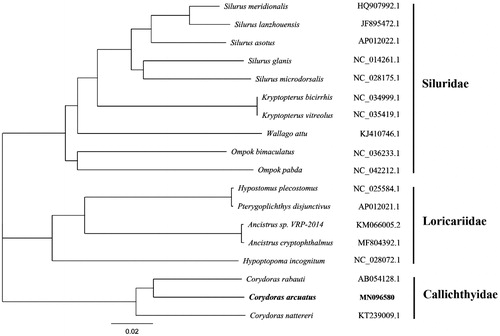Abstract
Corydoras arcuatus is a kind of famous and precious ornamental fish. In this study, the complete mitochondrial genome yielded by next-generation sequencing of Corydoras arcuatus was assembled and analyzed. The total length of the mitochondrial genome is 16,822 bp, with the base composition of 32.40% A, 26.10% T, 26.30% C, and 15.20% G. It contains two ribosomal RNA genes, 13 protein-coding genes, 22 transfer RNA genes, and a major non-coding control region (D-loop region). The arrangement of these genes is the same as that found in the Siluriformes. All the protein initiation codons are ATG, except for cox1 that begins with GTG. The complete mitogenomes of C. arcuatus and other 17 species from nine genera were used for phylogenetic analysis by Neighbour-Joining method. The topology demonstrated that all species are divided into three groups (Siluridae, Loricariidae, and Callichthyidae), and the C. arcuatus was clustered with C. rabauti and C. nattereri.
‘Mouse fish’ contains the species from the genera Aspidoras, Brochis, and Corydoras belong to subfamily Corydoradinae. Because there are two small beards next to the mouth, which is like a little mouse swimming in the water, it is called ‘Mouse fish’. Arched corydoras (Corydoras arcuatus), named ‘Indian mouse’ or ‘arched mouse’ in Chinese ornamental fish market, is a kind of famous and precious ornamental mouse fish. The colour pattern forms an even arch (hence the scientific name) of dark stripe from the snout to the lower back. Sometimes the cleithrum will have an iridescent gold or bronze color. It is very similar to other Corydoras species.
In order to distinguish and identify the species more accurately, we determined the mitochondrial genome sequence of the ‘arched mouse’ C. arcuatus using next-generation sequencing technology. Also, mitochondrial genome structure and phylogeny were analyzed. The living body of C. arcuatus was collected from the Red Star Ornamental Fish Market in Changsha, Hunan Province, China (113.03 E, 28.09 N). After aneasthesia with MS-222 (3-Aminobenzoic acid ethyl ester methanesulfonate), dorsal muscle tissue was collected and preserved in 99% ethanol in Museum of Hunan Agricultural University. After DNA extraction (Tissue DNA Kit D3396-02, Omega, bio-tek) and sequencing library construction (Sangon Biotech, Shanghai), paired end reads were sequenced using HiSeq XTen PE 150 of Illumina. BBduk and BLAST + were used to assess and monitor data quality. NOVOPlasty and SPAdes were used for de novo assembly. MITOS2 server and Geneious R11 (Liu et al. Citation2019; Tan et al. Citation2019) were used to predict and annotate the mitochondrial genome. Geneious Tree Builder was utilized to build Neighbor-Joining phylogenetic tree with Tamura-Nei (genetic distance model) and global aligment with free end gaps (aligment type).
Totally 18,639,450 high-quality clean reads (150 bp PE read length) were obtained. The total length of the mitochondrial genome is 16,822 bp (GenBank accession number: MN096580), with the base composition of 32.40% A, 26.10% T, 26.30% C, and 15.20% G. It contains two ribosomal RNA genes, 13 protein-coding genes, 22 transfer RNA genes, and a major non-coding control region (D-loop region). The arrangement of these genes is the same as that found in the Siluriformes (Saitoh et al. Citation2003; Liu et al. Citation2019). All the protein initiation codons are ATG, except for cox1 that begins with GTG. The complete mitogenomes of C. arcuatus and other 17 species from 9 genera were used for phylogenetic analysis by Neighbor-Joining method. The topology demonstrated that all species are divided into three groups (Siluridae, Loricariidae and Callichthyidae), and the C. arcuatus was clustered with C. rabauti and C. nattereri (). The information of the mitogenome provides a basis for future phylogenetic studies and species identification of Corydoras.
Disclosure statement
No potential conflict of interest was reported by the authors.
Additional information
Funding
References
- Tan J, Yin Z, Huang H, Zeng C. 2019. Characterization and phylogenetic analysis of Acheilognathus chankaensis mitochondrial genome. Mitochondrial DNA B. 4:1148–1149.
- Liu Q, Xu B, Xiao T. 2019. Complete mitochondrial genome of Corydoras duplicareus (Teleostei, Siluriformes, Callichthyidae). Mitochondrial DNA B. 4:1832–1833.
- Saitoh K, Miya M, Inoue JG, Ishiguro NB, Nishida M. 2003. Mitochondrial genomics of ostariophysan fishes: perspectives on phylogeny and biogeography. J Mol Evol. 56:464–472.

